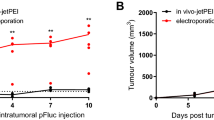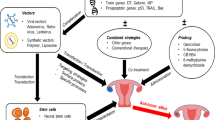Abstract
Linear polyethylenimine (L-PEI) is an efficient transfection agent for ovarian carcinoma cells in vitro and ex vivo. In the present work, we go a step further and evaluate the efficacy of L-PEI in human ovarian tumor nodes developed in mice. PEI/DNA complexes were administered intraperitoneally instead of intravenously to avoid sequestering of complexes in the lung and liver and to allow transfection of nonvascularized tumor nodes. Plasmid biodistribution was studied by PCR and gene expression was characterized using complementary luciferase and β-galactosidase assays. Intraperitoneal (i.p.) injection of L-PEI/DNA complexes allowed the straightforward distribution of plasmid in the whole peritoneal cavity. Gene expression occurred in many organs, but tumor nodes appeared as preferential sites for transgene expression. The i.p. delivery route allowed repeated injections and administration of large amounts of DNA (up to 400 μg) without signs of toxicity, even for doses well beyond the intravenous lethal dose. Transgene expression was dose-dependent and transient. However, multiple injections allowed its persistence to increase. These results provide encouraging elements towards the development of PEI-based gene therapy protocols for the treatment of advanced stage ovarian carcinoma.
This is a preview of subscription content, access via your institution
Access options
Subscribe to this journal
Receive 12 print issues and online access
$259.00 per year
only $21.58 per issue
Buy this article
- Purchase on Springer Link
- Instant access to full article PDF
Prices may be subject to local taxes which are calculated during checkout




Similar content being viewed by others
References
Iwai M, Harada Y, Tanaka S, Muramatsu A, Mori T, Kashima K et al. Polyethylenimine-mediated suicide gene transfer induces a therapeutic effect for hepatocellular carcinoma in vivo by using an Epstein–Barr virus-based plasmid vector. Biochem Biophys Res Commun 2002; 291: 48–54.
Aoki K, Furuhata S, Hatanaka K, Maeda M, Remy JS, Behr JP et al. Polyethylenimine-mediated gene transfer into pancreatic tumor dissemination in the murine peritoneal cavity. Gene Therapy 2001; 8: 508–514.
Vernejoul F, Faure P, Benali N, Calise D, Tiraby G, Pradayrol L et al. Antitumor effect of in vivo somatostatin receptor subtype 2 gene transfer in primary and metastatic pancreatic cancer models. Cancer Res 2002; 62: 6124–6131.
Poulain L, Ziller C, Muller CD, Erbacher P, Bettinger T, Rodier JF et al. Ovarian carcinoma cells are effectively transfected by polyethylenimine (PEI) derivatives. Cancer Gene Ther 2000; 7: 644–652.
Ziller C, Lincet H, Muller CD, Staedel C, Behr JP, Poulain L . The cyclin-dependent kinase inhibitor p21(cip1/waf1) enhances the cytotoxicity of ganciclovir in HSV-tk transfected ovarian carcinoma cells. Cancer Lett 2004; 212: 43–52.
Dolivet G, Merlin JL, Barberi-Heyob M, Ramacci C, Erbacher P, Parache RM et al. In vivo growth inhibitory effect of iterative wild-type p53 gene transfer in human head-and-neck carcinoma xenografts using glucosylated polyethylenimine nonviral vector. Cancer Gene Ther 2002; 9: 708–714.
Merlin JL, Dolivet G, Dubessy C, Festor E, Parache RM, Verneuil L et al. Improvement of nonviral p53 gene transfer in human carcinoma cells using glucosylated polyethylenimine derivatives. Cancer Gene Ther 2001; 8: 203–210.
Densmore CL, Kleinerman ES, Gautam A, Jia SF, Xu B, Worth LL et al. Growth suppression of established human osteosarcoma lung metastases in mice by aerosol gene therapy with PEI-p53 complexes. Cancer Gene Ther 2001; 8: 619–627.
Gautam A, Waldrep JC, Orson FM, Kinsey BM, Xu B, Densmore CL . Topical gene therapy for pulmonary diseases with PEI-DNA aerosol complexes. Methods Mol Med 2003; 75: 561–572.
Jia SF, Worth LL, Densmore CL, Xu B, Duan X, Kleinerman ES . Aerosol gene therapy with PEI: IL-12 eradicates osteosarcoma lung metastases. Clin Cancer Res 2003; 9: 3462–3468.
Ohana P, Gofrit O . Regulatory sequences of the H19 gene in DNA-based therapy of bladder cancer. Gene Ther Mol Biol 2004; 8: 181–192.
Behbakht K, Benjamin I, Chiu HC, Eck SL, Van Deerlin PG, Rubin SC et al. Adenovirus-mediated gene therapy of ovarian cancer in a mouse model. Am J Obstet Gynecol 1996; 175: 1260–1265.
Hasenburg A, Tong XW, Fischer DC, Rojas-Martinez A, Nyberg-Hoffman C, Kaplan AL et al. Adenovirus-mediated thymidine kinase gene therapy in combination with topotecan for patients with recurrent ovarian cancer: 2.5-year follow-up. Gynecol Oncol 2001; 83: 549–554.
McNeish IA, Green NK, Gilligan MG, Ford MJ, Mautner V, Young LS et al. Virus-directed enzyme prodrug therapy for ovarian and pancreatic cancer using retrovirally delivered E. coli nitroreductase and CB1954. Gene Therapy 1998; 5: 1061–1069.
Rosenfeld ME, Wang M, Siegal GP, Alvarez RD, Mikheeva G, Krasnykh V et al. Adenoviral-mediated delivery of herpes simplex virus thymidine kinase results in tumor reduction and prolonged survival in a SCID mouse model of human ovarian carcinoma. J Mol Med 1996; 74: 455–462.
Tong XW, Block A, Chen SH, Contant CF, Agoulnik I, Blankenburg K et al. In vivo gene therapy of ovarian cancer by adenovirus-mediated thymidine kinase gene transduction and ganciclovir administration. Gynecol Oncol 1996; 61: 175–179.
Tong XW, Agoulnik I, Blankenburg K, Contant CF, Hasenburg A, Runnebaum LB et al. Human epithelial ovarian cancer xenotransplants into nude mice can be cured by adenovirus-mediated thymidine kinase gene therapy. Anticancer Res 1997; 17: 811–813.
Mujoo K, Maneval DC, Anderson SC, Gutterman JU . Adenoviral-mediated p53 tumor suppressor gene therapy of human ovarian carcinoma. Oncogene 1996; 12: 1617–1623.
Agarwal R, Kaye SB . Ovarian cancer: strategies for overcoming resistance to chemotherapy. Nat Rev Cancer 2003; 3: 502–516.
Barnes MN, Deshane JS, Rosenfeld M, Siegal GP, Curiel DT, Alvarez RD . Gene therapy and ovarian cancer: a review. Obstet Gynecol 1997; 89: 145–155.
Niculescu-Duvaz I, Spooner R, Marais R, Springer CJ . Gene-directed enzyme prodrug therapy. Bioconjug Chem 1998; 9: 4–22.
Robertson III MW, Barnes MN, Rancourt C, Wang M, Grim J, Alvarez RD et al. Gene therapy for ovarian carcinoma. Semin Oncol 1998; 25: 397–406.
Chollet P, Favrot MC, Hurbin A, Coll JL . Side-effects of a systemic injection of linear polyethylenimine-DNA complexes. J Gene Med 2002; 4: 84–91.
Goula D, Remy JS, Erbacher P, Wasowicz M, Levi G, Abdallah B et al. Size, diffusibility and transfection performance of linear PEI/DNA complexes in the mouse central nervous system. Gene Ther 1998; 5: 712–717.
Zou SM, Erbacher P, Remy JS, Behr JP . Systemic linear polyethylenimine (L-PEI)-mediated gene delivery in the mouse. J Gene Med 2000; 2: 128–134.
DiSaia PJ, Bloss JD . Treatment of ovarian cancer: new strategies. Gynecol Oncol 2003; 90: S24–S32.
Abdallah B, Hassan A, Benoist C, Goula D, Behr JP, Demeneix BA . A powerful nonviral vector for in vivo gene transfer into the adult mammalian brain: polyethylenimine. Hum Gene Ther 1996; 7: 1947–1954.
Ferrari S, Moro E, Pettenazzo A, Behr JP, Zacchello F, Scarpa M . ExGen 500 is an efficient vector for gene delivery to lung epithelial cells in vitro and in vivo. Gene Therapy 1997; 4: 1100–1106.
Wu K, Meyers CA, Bennett JA, King MA, Meyer EM, Hughes JA . Polyethylenimine-mediated NGF gene delivery protects transected septal cholinergic neurons. Brain Res 2004; 1008: 284–287.
Wightman L, Kircheis R, Rossler V, Carotta S, Ruzicka R, Kursa M et al. Different behavior of branched and linear polyethylenimine for gene delivery in vitro and in vivo. J Gene Med 2001; 3: 362–372.
Wiseman JW, Goddard CA, McLelland D, Colledge WH . A comparison of linear and branched polyethylenimine (PEI) with DCChol/DOPE liposomes for gene delivery to epithelial cells in vitro and in vivo. Gene Therapy 2003; 10: 1654–1662.
Bragonzi A, Boletta A, Biffi A, Muggia A, Sersale G, Cheng SH et al. Comparison between cationic polymers and lipids in mediating systemic gene delivery to the lungs. Gene Therapy 1999; 6: 1995–2004.
Bragonzi A, Dina G, Villa A, Calori G, Biffi A, Bordignon C et al. Biodistribution and transgene expression with nonviral cationic vector/DNA complexes in the lungs. Gene Therapy 2000; 7: 1753–1760.
Koshkina NV, Agoulnik IY, Melton SL, Densmore CL, Knight V . Biodistribution and pharmacokinetics of aerosol and intravenously administered DNA-polyethyleneimine complexes: optimization of pulmonary delivery and retention. Mol Ther 2003; 8: 249–254.
Acknowledgements
We thank M-C Bon for the technical assistance in animal care, and Dr J-F Héron, Dr H Crouet and Dr F Joly, clinicians of the F Baclesse Cancer Center, for their constant support and their active participation in the field of the development of innovative therapeutics in the ovarian cancer work group. This work was supported by the ‘Ligue Contre le Cancer’ (Comités du Calvados et de l'Orne), the ‘Association pour la Recherche contre le Cancer’ (ARC), The Association ‘Cœur et Cancer’ (Cherbourg, France), the ‘Conseil Régional de Basse-Normandie’, the French State, the European Community (Fonds Européens pour le Développement de la Recherche–FEDER) and the ‘Agence Nationale de Valorisation de la Recherche’ (ANVAR).
Author information
Authors and Affiliations
Corresponding author
Rights and permissions
About this article
Cite this article
Louis, MH., Dutoit, S., Denoux, Y. et al. Intraperitoneal linear polyethylenimine (L-PEI)-mediated gene delivery to ovarian carcinoma nodes in mice. Cancer Gene Ther 13, 367–374 (2006). https://doi.org/10.1038/sj.cgt.7700893
Received:
Revised:
Accepted:
Published:
Issue Date:
DOI: https://doi.org/10.1038/sj.cgt.7700893
Keywords
This article is cited by
-
Evaluation of in vivo antitumor effects of ANT2 shRNA delivered using PEI and ultrasound with microbubbles
Gene Therapy (2015)
-
Fatty Acid-Based Strategy for Efficient Brain Targeted Gene Delivery
Pharmaceutical Research (2013)
-
Transgene therapy for rat anti-Thy1.1 glomerulonephritis via mesangial cell vector with a polyethylenimine/decorin nanocomplex
Nanoscale Research Letters (2012)
-
Biodistribution and blood clearance of plasmid DNA administered in arginine peptide complexes
Genetic Vaccines and Therapy (2011)
-
Matrix-assisted pulsed laser evaporation of chemoselective polymers
Applied Physics A (2011)



